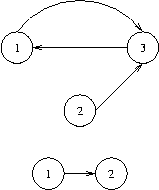The Bottom of a Graph
| Time Limit: 3000MS | Memory Limit: 65536K | |
| Total Submissions: 8902 | Accepted: 3688 |
Description
We will use the following (standard) definitions from graph theory. Let
V be a nonempty and finite set, its elements being called vertices (or nodes). Let
E be a subset of the Cartesian product
V×V, its elements being called edges. Then
G=(V,E) is called a directed graph.
Let n be a positive integer, and let p=(e1,...,en) be a sequence of length n of edges ei∈E such that ei=(vi,vi+1) for a sequence of vertices (v1,...,vn+1). Then p is called a path from vertex v1 to vertex vn+1 in G and we say that vn+1 is reachable from v1, writing (v1→vn+1).
Here are some new definitions. A node v in a graph G=(V,E) is called a sink, if for every node w in G that is reachable from v, v is also reachable from w. The bottom of a graph is the subset of all nodes that are sinks, i.e., bottom(G)={v∈V|∀w∈V:(v→w)⇒(w→v)}. You have to calculate the bottom of certain graphs.
Let n be a positive integer, and let p=(e1,...,en) be a sequence of length n of edges ei∈E such that ei=(vi,vi+1) for a sequence of vertices (v1,...,vn+1). Then p is called a path from vertex v1 to vertex vn+1 in G and we say that vn+1 is reachable from v1, writing (v1→vn+1).
Here are some new definitions. A node v in a graph G=(V,E) is called a sink, if for every node w in G that is reachable from v, v is also reachable from w. The bottom of a graph is the subset of all nodes that are sinks, i.e., bottom(G)={v∈V|∀w∈V:(v→w)⇒(w→v)}. You have to calculate the bottom of certain graphs.
Input
The input contains several test cases, each of which corresponds to a directed graph
G. Each test case starts with an integer number
v, denoting the number of vertices of
G=(V,E), where the vertices will be identified by the integer numbers in the set
V={1,...,v}. You may assume that
1<=v<=5000. That is followed by a non-negative integer
e and, thereafter,
e pairs of vertex identifiers
v1,w1,...,ve,we with the meaning that
(vi,wi)∈E. There are no edges other than specified by these pairs. The last test case is followed by a zero.
Output
For each test case output the bottom of the specified graph on a single line. To this end, print the numbers of all nodes that are sinks in sorted order separated by a single space character. If the bottom is empty, print an empty line.


Sample Input
3 3 1 3 2 3 3 1 2 1 1 2 0
Sample Output
1 3 2
Source
Ulm Local 2003
看图就能理解,其实就是找缩点后,出度为0的点,所以就是tarjan+缩点了
看图就能理解,其实就是找缩点后,出度为0的点,所以就是tarjan+缩点了
#include<map>
#include<set>
#include<list>
#include<stack>
#include<queue>
#include<vector>
#include<cmath>
#include<cstdio>
#include<cstring>
#include<iostream>
#include<algorithm>
using namespace std;
const int N = 100010;
const int M = 200010;
const int inf = 0x3f3f3f3f;
int DFN[N];
int low[N];
int block[N];
int Stack[N];
int out[N];
bool instack[N];
int head[N];
int ans[N];
int tot, sccnum, index, top, n, m;
struct node
{
int next;
int to;
}edge[M];
void addedge(int from, int to)
{
edge[tot].to = to;
edge[tot].next = head[from];
head[from] = tot++;
}
void init()
{
memset( instack, 0, sizeof(instack) );
memset( DFN, 0, sizeof(DFN) );
memset( low, 0, sizeof(low) );
memset( out, 0, sizeof(out) );
sccnum = index = top = 0;
}
void tarjan(int u)
{
DFN[u] = low[u] = ++index;
Stack[top++] = u;
instack[u] = 1;
for (int i = head[u]; i != -1; i = edge[i].next)
{
int v = edge[i].to;
if (DFN[v] == 0)
{
tarjan(v);
if (low[u] > low[v])
{
low[u] = low[v];
}
}
else if (instack[v])
{
if (low[u] > DFN[v])
{
low[u] = DFN[v];
}
}
}
if (DFN[u] == low[u])
{
sccnum++;
do
{
top--;
block[Stack[top]] = sccnum;
instack[Stack[top]] = 0;
}while (Stack[top] != u);
}
}
void solve()
{
init();
for (int i = 1; i <= n; i++)
{
if (DFN[i] == 0)
{
tarjan(i);
}
}
for (int i = 1; i <= n; i++)
{
for (int j = head[i]; j != -1; j = edge[j].next)
{
if (block[i] != block[edge[j].to])
{
out[block[i]]++;
}
}
}
int cnt = 0;
for (int i = 1; i <= n; i++)
{
if (out[block[i]] == 0)
{
ans[cnt++] = i;
}
}
sort(ans, ans + cnt);
printf("%d", ans[0]);
for (int i = 1; i < cnt; i++)
{
printf(" %d", ans[i]);
}
printf("\n");
}
int main()
{
while (~scanf("%d", &n), n)
{
scanf("%d", &m);
memset( head, -1, sizeof(head) );
tot = 0;
int u, v;
for (int i = 0; i < m; i++)
{
scanf("%d%d", &u, &v);
addedge(u, v);
}
solve();
}
return 0;
}























 225
225











 被折叠的 条评论
为什么被折叠?
被折叠的 条评论
为什么被折叠?








